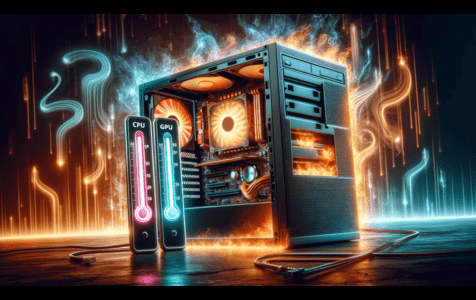When considering your computer’s health, a key aspect is understanding the normal temperature for CPU and GPU. These crucial components, responsible for computing and graphics processing, play a significant role in your system’s functionality. Monitoring CPU and GPU temperatures is vital, not only for curiosity but also for maintaining their optimal performance and longevity, particularly under heavy loads like gaming, where the average temperature for CPU and GPU becomes a critical factor.
Optimal For Gaming
| Component | Optimal Temperature Range for Gaming | Maintenance Tips |
|---|---|---|
| CPU | 70-80°C (158-176°F) |
|
| GPU | 65-85°C (149–185°F) |
|
Additional Notes:
|
||
The optimal temperature for CPU and GPU varies based on model, workload, and cooling efficiency. For CPUs, a safe temperature during gaming is typically between 70–80°C (158–176°F). GPUs, designed to endure higher temperatures, normally range from 65–85°C (149–185°F) under gaming stress. This highlights the importance of knowing the ideal temperature for CPU and GPU during such high-load activities.
Keeping Temperatures Within Safe Limits
High temperatures can stress your hardware and lead to a reduced lifespan, decreased performance, or, in extreme cases, permanent damage. Both the CPU and GPU are designed with safety mechanisms that throttle performance to cool down these components when they reach critical temperatures. In the worst-case scenario, your computer might shut down to prevent damage to its components due to overheating.
Monitoring During Gaming Sessions
The first step to managing your system’s temperatures is monitoring them. Various tools are available that offer insights into the temperature readings of your system’s components, such as software that provides real-time tracking of temperatures, fan speeds, and voltages. These utilities provide real-time tracking and detailed information on various hardware metrics, including temperatures, fan speeds, and voltages.
Community Insights
Within communities, such as Reddit’s r/buildapc subreddit, gamers and builders often share their experiences and guidelines for ideal temperatures. This collective wisdom is invaluable for learning about the real-world expectations for CPU and GPU temperatures. For example, discussions in online forums provide insights on optimal temperature ranges and perceived dangerous thresholds for CPU and GPU hardware.
In the realm of PC gaming, managing the temperatures of your CPU and GPU is crucial, especially considering their varying optimal ranges. Real-world examples, like a user’s experience with the Intel Arc A770 graphics card, shed light on the complexities of temperature management. This particular case, discussed in a community forum, highlights the challenges and solutions in controlling GPU temperatures during intense gaming sessions. Such insights are invaluable in understanding the practical aspects of maintaining ideal temperatures for both CPUs and GPUs.
In exploring the complexities of managing GPU and CPU temperatures, a discussion on the AMD community forum offers practical insights. A user reported unusually high temperatures for their RX 550, sparking a conversation about normal operating ranges and troubleshooting strategies. This thread, found at GPU and CPU Hotter Than Normal RX 550, delves into various factors that can influence temperature, including hardware maintenance and the potential need for replacing thermal paste. It serves as a valuable resource for understanding temperature dynamics in gaming setups.
How to Maintain or Lower Your System Temperatures
To keep your system cool, there are several steps you can take:
- Make sure your PC case has adequate ventilation and is free from dust buildup. Dust can act like an insulator, trapping heat inside the case.
- Check that all your fans are functioning correctly and consider the fan configuration within your case. Ideally, you should have a balanced setup of intake and exhaust fans.
- Look at your ambient room temperature. Sometimes, the simple act of cooling the room can lead to a substantial temperature drop in your system.
- Evaluate your current cooling solutions, such as heatsinks and thermal paste application. Upgrading or re-applying thermal paste can significantly lower CPU temperatures.
- Manage your system’s workload. Overclocking can push the temperatures higher. Hence, be cautious with overclocking profiles, especially during hot seasons or intense gaming sessions.
To further explore effective methods for reducing CPU temperatures, especially in gaming laptops, you can refer to detailed guidelines and tips at How to Reduce CPU Temperature in a Gaming Laptop.
Conclusion
There’s no one-size-fits-all answer for the “normal” temperature for your CPU and GPU during gaming; it varies based on several factors. However, arming yourself with the appropriate knowledge, using the right tools for monitoring, and taking proactive steps can help you maintain healthy temperatures and a stable system.
